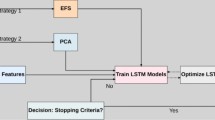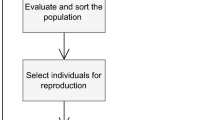Abstract
Air pollution prediction is a process of predicting the levels of air pollutants in a specific area over a given period. Since LSTM (Long Short-Term Memory) networks are particularly effective in capturing long-term dependencies and patterns in sequential data, they are widely-used for air pollution prediction. However, designing appropriate LSTM architectures and hyperparameters for given tasks can be challenging, which are normally determined by users in existing LSTM-based methods. Note that Genetic Algorithm (GA) is an effective optimization technique, and local search in augmenting the global search ability of GA has been proved, which is rarely considered by existing GA-optimzied LSTM methods. In this work, simultaneous LSTM architecture and hyperparameter search based on GA and local search techniques is investigated for air pollution prediction. Specifically, a new LSTM model search method is designed, termed as HGA-LSTM. HGA is a hybrid GA, which is proposed by integrating GA with local search adaptively. Based on HGA, HGA-LSTM is developed to search for LSTM models with simultaneous LSTM architecture and hyperparameter optimization. In HGA-LSTM, a new crossover is designed to be adaptive to the variable-length representation of LSTM models. The proposed HGA-LSTM is compared with widely-used LSTM-based and nonLSTM-based prediction methods on UCI (University of California Irvine) datasets for air pollution prediction. Results show that HGA-LSTM is generally better than both types of reference methods with its evolved LSTM models achieving lower mean square/absolute errors. Moreover, compared with a baseline method (a GA without local search), HGA-LSTM converges to lower error values, which reflects that HGA has better search ability than GA.











Similar content being viewed by others
Explore related subjects
Discover the latest articles, news and stories from top researchers in related subjects.Data availability
The data/material used or generated in this work is available from the corresponding author on reasonable request.
References
H.B. Ali, A. Roman, Designing urban transit network using memetic algorithm, in 2021 IEEE Congress on Evolutionary Computation (CEC) (2021)
M. Asadujjaman, H.F. Rahman, R.K. Chakrabortty, M.J. Ryan, Multi-operator immune genetic algorithm for project scheduling with discounted cash flows. Expert Syst. Appl. 195, 116589 (2022)
S. Balaraman, P. Partheeban, P.N. Elamparithi, S. Manimozhi, Application of LSTM models in predicting particulate matter (pm2.5) levels for urban area. J. Eng. Res. 10(3B), 71–90 (2022)
A.H.C. Correia, D.E. Worrall, R. Bondesan, Neural simulated annealing (2022)
H. Dai, G. Huang, H. Zeng, F. Yang, PM2.5 concentration prediction based on spatiotemporal feature selection using XGBoost-MSCNN-GA-LSTM. Sustainability 13(21), 12071–12094 (2021)
X. Dai, J. Liu, Y. Li, A recurrent neural network using historical data to predict time series indoor PM2.5 concentrations for residential buildings. Indoor Air 31(4), 1228–1237 (2021)
F. D’Angelo, GGA: A modified genetic algorithm with gradient-based local search for solving constrained optimization problems. Inform. Sci. Int. J. 547(1), 136–162 (2021)
D.D. Hema, K.A. Kumar, An optimized intelligent driver’s aggressive behaviour prediction model using GA-LSTM. Int. J. Perform. Eng. 17(10), 880–888 (2021)
S.D. Immanuel, U.K. Chakraborty, Genetic algorithm: an approach on optimization. In 2019 International Conference on Communication and Electronics Systems (ICCES) (2019)
D. Jiahui, G. Yaping, L. Jun, Z. Zhiyao, Air-quality prediction based on the ARIMA-CNN-LSTM combination model optimized by dung beetle optimizer. Sci. Rep. 13, 12127 (2023)
W. Kai, H. Yu, H. Lianzhong, G. Xin, L. Xing, M. Zhongmin, M. Ranqi, J. Xiaoli, A novel GA-LSTM-based prediction method of ship energy usage based on the characteristics analysis of operational data. Energy 282, 128910 (2023)
S. Kumari, N. Kumar, P.S. Rana, Big data analytics for energy consumption prediction in smart grid using genetic algorithm and long short term memory. Comput. Inform. 40(1), 29–56 (2021)
A. Kuri, A statistical genetic algorithm, in National Computation Meeting, pp. 1–7 (2022)
D. Li, J. Liu, Y. Zhao, Prediction of multi-site PM2.5 concentrations in Beijing using CNN-Bi LSTM with CBAM. Atmosphere 13(10), 1719–1737 (2022)
Z. Li, Z. Li, Z. Li, Y. Li, Application of GA-LSTM model in cable joint temperature prediction. In 2020 7th International Forum on Electrical Engineering and Automation (IFEEA) (2020)
J. Liang, Y. Xue, Bloat-aware GP-based methods with bloat quantification. Appl. Intell. 52(4), 4211–4225 (2022)
J. Liang, Y. Xue, J. Wang, Genetic programming based feature construction methods for foreground object segmentation. Eng. Appl. Artif. Intell. 89(Mar.), 103334.1-103334.12 (2020)
B. Lindemann, T. Müller, H. Vietz, N. Jazdi, M. Weyrich, A survey on long short-term memory networks for time series prediction. Proc. CIRP 99, 650–655 (2020)
J. Liu, D. Zhou, W. Jin, Prediction of nucleosome dynamic interval based on long-short-term memory network (LSTM). J. Bioinform. Comput. Biol. 20(3), 2250009 (2022)
P. Mohapatra, S. Roy, K.N. Das, S. Dutta, M.S.S. Raju, A review of evolutionary algorithms in solving large scale benchmark optimisation problems. Int. J. Math. Op. Res. 21(1), 104–126 (2022)
T.H.T. Nguyen, Q.B. Phan, Hourly day ahead wind speed forecasting based on a hybrid model of EEMD, CNN-Bi-LSTM embedded with GA optimization, in 2022 The 4th International Conference on Clean Energy and Electrical Systems, vol. 8, pp. 53–60 (2022)
L. Qing, PM2.5 concentration prediction using GRA-GRU network in air monitoring. Sustainability 15(3), 1973–1988 (2023)
W. Rui, Z. Zhihe, T. Hongfeng, P. Wojciech, S. Vladimir, Q-learning based fault estimation and fault tolerant iterative learning control for mimo systems. ISA Trans. 142, 123–135 (2023)
M. Saez, M.A. Barcelo, Spatial prediction of air pollution levels using a hierarchical bayesian spatiotemporal model in Catalonia. Spain. Environ. Model. Softw. 151(May), 105369 (2022)
D. Santra, A. Mukherjee, K. Sarker, S. Mondal, Hybrid genetic algorithm-gravitational search algorithm to optimize multi-scale load dispatch. Int. J. Appl. Metaheur. Comput. 12(3), 28–53 (2021)
F. Shahid, A. Zameer, M. Muneeb, A novel genetic LSTM model for wind power forecast. Energy 223(1), 120069 (2021)
W. Shih-Jung, H. Bo-Jhen, H. Ming-Hui, A deep learning-based air quality index prediction model using lstm and reference stations: a real application in taiwan. In Australasian Telecommunication Networks and Applications Conference (2023)
P. Siarry, Handbook of memetic algorithms. Comput. Rev. 53(10), 597 (2012)
S. Tsokov, M. Lazarova, A. Aleksieva-Petrova, A hybrid spatiotemporal deep model based on CNN and LSTM for air pollution prediction. Sustainability 14(9), 5104–5141 (2022)
J. Wang, Z. Wang, M. Deng, H. Zou, K. Wang, Heterogeneous spatiotemporal copula-based kriging for air pollution prediction. Trans. GIS 25(6), 3210–3232 (2021)
Y. Yu, M. Zhang, Control chart recognition based on the parallel model of CNN and LSTM with ga optimization. Expert Syst. Appl. 185, 115689–1156702 (2021)
M. Zhang, D. Wu, R. Xue, Hourly prediction of PM2.5 concentration in beijing based on Bi-LSTM neural network. Multim. Tools Appl. 80(16), 24455–24468 (2021)
C. Zhou, H. Tao, Y. Chen, V. Stojanovic, W. Paszke, Robust point-to-point iterative learning control forconstrained systems: A minimum energy approach. Int. J. Robust Nonlinear Control 32, 10139–10161 (2022)
B. Zhuohao, Residential electricity prediction based on GA-LSTM modeling. Energy Rep. 11, 6223–6232 (2024)
Acknowledgements
Not applicable.
Funding
This work is supported by National Natural Science Foundation of China with the grant number 61902281.
Author information
Authors and Affiliations
Contributions
Jiayu Liang is responsible for methodology, result analyses and writing. Yaxin Lu is responsible for experiments and result visualization. All authors reviewed the manuscript.
Corresponding author
Ethics declarations
Conflict of interest
The authors declare that they have no Conflict of interest.
Ethics approval and consent to participate
Not applicable.
Consent for publication
Not applicable.
Additional information
Publisher's Note
Springer Nature remains neutral with regard to jurisdictional claims in published maps and institutional affiliations.
Rights and permissions
Springer Nature or its licensor (e.g. a society or other partner) holds exclusive rights to this article under a publishing agreement with the author(s) or other rightsholder(s); author self-archiving of the accepted manuscript version of this article is solely governed by the terms of such publishing agreement and applicable law.
About this article
Cite this article
Liang, J., Lu, Y. & Su, M. Hga-lstm: LSTM architecture and hyperparameter search by hybrid GA for air pollution prediction. Genet Program Evolvable Mach 25, 20 (2024). https://doi.org/10.1007/s10710-024-09493-3
Received:
Revised:
Accepted:
Published:
DOI: https://doi.org/10.1007/s10710-024-09493-3




